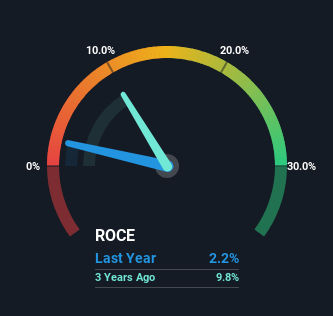- South Korea
- /
- Medical Equipment
- /
- KOSDAQ:A164060
Some Investors May Be Worried About Ilooda's (KOSDAQ:164060) Returns On Capital

If you're not sure where to start when looking for the next multi-bagger, there are a few key trends you should keep an eye out for. Firstly, we'll want to see a proven return on capital employed (ROCE) that is increasing, and secondly, an expanding base of capital employed. This shows us that it's a compounding machine, able to continually reinvest its earnings back into the business and generate higher returns. However, after briefly looking over the numbers, we don't think Ilooda (KOSDAQ:164060) has the makings of a multi-bagger going forward, but let's have a look at why that may be.
Return On Capital Employed (ROCE): What Is It?
Just to clarify if you're unsure, ROCE is a metric for evaluating how much pre-tax income (in percentage terms) a company earns on the capital invested in its business. The formula for this calculation on Ilooda is:
Return on Capital Employed = Earnings Before Interest and Tax (EBIT) ÷ (Total Assets - Current Liabilities)
0.022 = ₩1.4b ÷ (₩93b - ₩30b) (Based on the trailing twelve months to December 2023).
So, Ilooda has an ROCE of 2.2%. In absolute terms, that's a low return and it also under-performs the Medical Equipment industry average of 12%.
See our latest analysis for Ilooda

While the past is not representative of the future, it can be helpful to know how a company has performed historically, which is why we have this chart above. If you're interested in investigating Ilooda's past further, check out this free graph covering Ilooda's past earnings, revenue and cash flow.
What Can We Tell From Ilooda's ROCE Trend?
On the surface, the trend of ROCE at Ilooda doesn't inspire confidence. To be more specific, ROCE has fallen from 9.8% over the last three years. However, given capital employed and revenue have both increased it appears that the business is currently pursuing growth, at the consequence of short term returns. If these investments prove successful, this can bode very well for long term stock performance.
On a side note, Ilooda's current liabilities have increased over the last three years to 32% of total assets, effectively distorting the ROCE to some degree. Without this increase, it's likely that ROCE would be even lower than 2.2%. Keep an eye on this ratio, because the business could encounter some new risks if this metric gets too high.
What We Can Learn From Ilooda's ROCE
While returns have fallen for Ilooda in recent times, we're encouraged to see that sales are growing and that the business is reinvesting in its operations. And the stock has followed suit returning a meaningful 26% to shareholders over the last three years. So should these growth trends continue, we'd be optimistic on the stock going forward.
If you want to continue researching Ilooda, you might be interested to know about the 1 warning sign that our analysis has discovered.
For those who like to invest in solid companies, check out this free list of companies with solid balance sheets and high returns on equity.
New: AI Stock Screener & Alerts
Our new AI Stock Screener scans the market every day to uncover opportunities.
• Dividend Powerhouses (3%+ Yield)
• Undervalued Small Caps with Insider Buying
• High growth Tech and AI Companies
Or build your own from over 50 metrics.
Have feedback on this article? Concerned about the content? Get in touch with us directly. Alternatively, email editorial-team (at) simplywallst.com.
This article by Simply Wall St is general in nature. We provide commentary based on historical data and analyst forecasts only using an unbiased methodology and our articles are not intended to be financial advice. It does not constitute a recommendation to buy or sell any stock, and does not take account of your objectives, or your financial situation. We aim to bring you long-term focused analysis driven by fundamental data. Note that our analysis may not factor in the latest price-sensitive company announcements or qualitative material. Simply Wall St has no position in any stocks mentioned.
About KOSDAQ:A164060
Ilooda
Researches, develops, manufactures, and sells medical devices in South Korea and internationally.
Low with imperfect balance sheet.
Market Insights
Community Narratives



